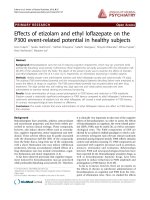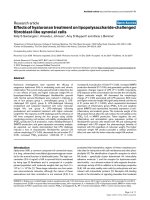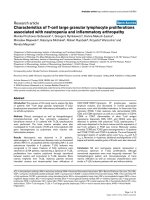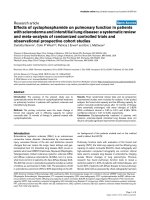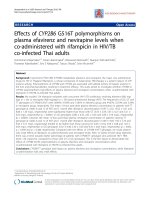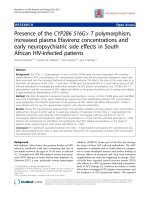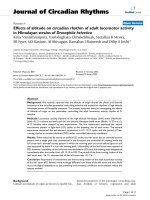Báo cáo y học: "Effects of triptolide from Radix Tripterygium wilfordii (Leigongteng) on cartilage cytokines and transcription fact" ppt
Bạn đang xem bản rút gọn của tài liệu. Xem và tải ngay bản đầy đủ của tài liệu tại đây (561.3 KB, 7 trang )
BioMed Central
Page 1 of 7
(page number not for citation purposes)
Chinese Medicine
Open Access
Research
Effects of triptolide from Radix Tripterygium wilfordii (Leigongteng)
on cartilage cytokines and transcription factor NF-κB: a study on
induced arthritis in rats
Cheng Xiao
1,2
, Jing Zhou
2
, Yinghui He
3
, Hongwei Jia
2
, Linhua Zhao
2
,
Ning Zhao
2
and Aiping Lu*
2,4
Address:
1
Institute of Clinical Medicine Research, China-Japan Friendship Hospital, Beijing 100029, PR China,
2
Institute of Basic Theory, China
Academy of Traditional Chinese Medicine, Beijing 100700, PR China,
3
National Pharmaceutical Engineering Centre for Herbal Preparations,
Jiangxi University of Traditional Chinese Medicine, Nanchang, Jiangxi 330006, PR China and
4
E-institutes of Shanghai Municipal Education
Commission (Shanghai University of Traditional Chinese Medicine), Shanghai 201203, PR China
Email: Cheng Xiao - ; Jing Zhou - ; Yinghui He - ;
Hongwei Jia - ; Linhua Zhao - ; Ning Zhao - ;
Aiping Lu* -
* Corresponding author
Abstract
Background: Triptolide, an active compound of Radix Tripterygium wilfordii, is immunosuppressive,
cartilage protective and anti-inflammatory both in human and animal studies of various
inflammatory and autoimmune diseases, including rheumatoid arthritis, but its therapeutic
mechanism remains unclear. The aim of this study is to investigate the effects of triptolide on
cartilage cytokines in the CIA model.
Methods: Sprague Dawley rats were immunized with type II collagen and orally administered with
triptolide. The arthritic scores and incidence changes of the rats were observed. The expression
of TNF-α, IL-6, COX-2 and NF-κB in paw cartilage was studied with immunohistochemical staining.
Results: Triptolide, at both high and low doses, significantly lowered the arthritic scores, delayed
the onset of arthritis and lowered the arthritis incidence. Triptolide treatment at both high and low
doses lowered the expression of TNF-α, IL-6, COX-2 and NF-κB in paw cartilage in arthritic rats.
Conclusion: Triptolide lowers the arthritic scores, delays the onset of collagen induced arthritis
and reduces the expressions of TNF-α, IL-6, NF-κB and COX-2 in paw cartilage in arthritic rats.
Background
Rheumatoid arthritis (RA) is a chronic disease that affects
peripheral joints in human. It is characterized by inflam-
mation and cellular proliferation in the synovial lining of
joints, which can result in progressive destruction of carti-
lage and subchondral bones [1]. Tumor necrosis factor-α
(TNF-α), interleukin-6 (IL-6), cycloxygenase-2 (COX-2)
and nuclear factor κB (NF-κB) play important roles in the
disease progression of RA [2-5].
Current treatments for RA include disease modifying
antirheumatic drugs (DMARDs), non-steroidal anti-
inflammatory drugs (NSAIDs), steroid and biological
response modifiers which all aim to slow the disease pro-
Published: 2 July 2009
Chinese Medicine 2009, 4:13 doi:10.1186/1749-8546-4-13
Received: 20 January 2009
Accepted: 2 July 2009
This article is available from: />© 2009 Xiao et al; licensee BioMed Central Ltd.
This is an Open Access article distributed under the terms of the Creative Commons Attribution License ( />),
which permits unrestricted use, distribution, and reproduction in any medium, provided the original work is properly cited.
Chinese Medicine 2009, 4:13 />Page 2 of 7
(page number not for citation purposes)
gression and prevent further joint damage. Patients on
these treatments may develop dependency on the medica-
tions and often suffer from side effects.
Triptolide is an active compound in the extract of Radix
Tripterygium wilfordii (Leigongteng) [6,7]. Triptolide is
immunosuppressive, cartilage protective and anti-inflam-
matory in vivo and effective on both humans and animals
inflicted by a range of inflammatory and autoimmune
diseases, such as RA [8-11]. The anti-inflammatory effects
of triptolide include the inhibition of IL-2 production in
mouse T cell hybridomas, inhibition of transcriptional
activation of NF-κB, suppression of NF-κB in T lym-
phocytes [12] and reduction of PGE
2
production in
human monocytes and RA synovial fibroblasts [13]. An
earlier study showed that triptolide reduced the incidence
and severity of arthritis in collagen induced arthritis (CIA)
model [14]. The effects of triptolide on cartilage TNF-α,
IL-6, COX-2 and NF-κB are unclear; thus the present study
investigates the effects of triptolide on cartilage cytokines
in the rat CIA model, which is a widely used animal model
of inflammatory polyarthritis with similarities to RA, and
primarily mediated by an autoimmune response [15-18].
Methods
Animals
Sixty male Sprague Dawley rats of 8–10 weeks old (180–
200 g body weight) were purchased from the Center for
Laboratory Animal Care, Chinese Academy of Medical
Sciences. Rats were randomly divided into four groups:
(1) control, (2) CIA, (3) high dose triptolide (TH) and (4)
low dose triptolide (TL). Rats were housed in a tempera-
ture-, humidity- and light-controlled environment with
free access to rodent chow and water. The light-dark cycle
was 12 hours (light phase from 06:00 to 18:00). The
rodent license of the laboratory (NO. SYXK 11-00-0039)
was issued by the Science and Technology Ministry of
China. The approval of the Institutional Animal Ethics
Committee was obtained before animal experiments were
carried out.
Induction of CIA and evaluation of arthritis
Soluble pure rat type II collagen (CII) was from Rikard
Holmdahl (Lund University, Sweden) and complete Fre-
und's adjuvant was purchased from Sigma Corporation,
USA. CIA was induced by immunization once with 0.15
mg CII emulsified with equal complete Freund's adjuvant
at the foot. Since eight days after immunization, the
degree of arthritis was examined every two days. The
severity of arthritis was expressed as mean arthritic index
on a 0–4 scale according to the following criteria: 0- no
edema, 1- slight edema and erythema limited to the foot
and/or ankle, 2- slight edema and erythema from the
ankle to the tarsal bone, 3- moderate edema and erythema
from the ankle to the tarsal bone and 4- edema and ery-
thema from the ankle to the entire leg. Each limb was
graded and the maximum possible score was 16 for each
animal. A score of one or above was considered arthritic.
Treatment of CIA with triptolide
Triptolide (Huangshi Pharmaceutical Factory, China) was
orally administered to the rats for one week after immuni-
zation, once a day, lasting for three weeks, at 18.62 μg per
5 ml per kg of body weight (TH) and 9.31 μg per 5 ml per
kg of body weight (TL). The rats in the control and CIA
groups were administered with 5 ml of saline per kg of
body weight.
Immunohistochemistry
The expression of TNF-α, IL-6, COX-2 and NF-κB in hind
paw cartilage was determined with immunohistochemical
staining kits (Wuhan Boster Biotech, China). The staining
was performed in accordance with the product manual.
Briefly, on day 28 after the immunization, hind paws were
dissected, fixed in ice-cold 4% phosphate-buffered para-
formaldehyde (pH7.4), decalcified in cold by 10% ethyl-
enediamine tetraacetic acid (EDTA) in phosphate
buffered saline (PBS) and cryostat-sectioned at 6 μm. The
sections were fixed in cold acetone for ten minutes,
washed in PBS and depleted of endogenous peroxidase by
treatment with 0.3% H
2
O
2
in absolute methanol for 15
minutes. After blocking nonspecific binding with 10%
normal rabbit serum in PBS for 30 minutes, the sections
were incubated with primary antibodies (rabbit anti-rat
TNF-α, IL-6, COX-2 and NF-κB antibodies) at appropriate
dilutions for one hour at 37°C, washed, incubated with
biotinylated goat anti-rabbit immunoglobulin G (IgG,),
washed and incubated with avidinbiotinylated horserad-
ish peroxidase complex (ABC) and diaminobenzidine tet-
rahydrochloride DAB (Elite kit, Vector Laboratories,
USA), then counterstained with hematoxylin. The positive
granule averages of three samples (6 scoops in each sam-
ple) in each section were determined by Q-win DC100
Image Analysis (Leica Microsystems, Germany). The per-
centage of positive granules in the whole screened area
was calculated.
Statistical analysis
Student-Newman-Keuls test was employed for variable
between groups when equal variances were assumed.
Dunnetts's t test for equal variances not assumed. Chi-
square test was employed for the incidence data analysis
(SPSS version 11.0). P values less than 0.05 were consid-
ered statistically significant.
Results
Effects of triptolide on arthritic scores and incidenceWe
used the CIA model in Sprague Dawley rats to investigate
the effects of triptolide on arthritis. The changes of arthri-
tis scores and arthritis incidence in the CIA and triptolide
Chinese Medicine 2009, 4:13 />Page 3 of 7
(page number not for citation purposes)
treatment groups are shown in Figures 1 and 2 respec-
tively. CIA was developed in rats immunized with CII.
Clinical signs (e.g. periarticular erythema and edema) of
CIA first appeared in the paw on Day 10 after immuniza-
tion (Figure 1). Day 20 after immunization, the arthritic
scores started to decrease in the TH and TL groups
(3.229<t<4.750, P < 0.01 or P < 0.001). Oral administra-
tion of TL to arthritic rats reversed paw edema as did TH
(0<t<0.709, P > 0.05). Triptolide delayed the onset of
arthritis (P < 0.01) and lowered arthritis incidence.
Effects of triptolide on proinflammatory cytokines, COX-2
and NF-
κ
B in cartilage
To investigate the actions of triptolide on CIA, we meas-
ured the levels of cartilage proinflammatory cytokines,
COX-2 and NF-κB in joints. Immunohistochemical stain-
ing of paraffin sections of the joints femoral and tibial
knee joint articular cartilage showed extensive positivity
for TNF-α, IL-6, COX-2 and NF-κB (Figures 3, 4, 5 and 6).
Positive cells markedly increased in the articular cartilage
in the CIA group, more so in the superficial than deep lay-
ers, while positive immunostaining for TNF-α, IL-6, COX-
2 and NF-κB in the control group was rare. In addition,
articular cartilage treated with triptolide in both TH and
TL groups showed limited and weak cytoplasmic staining
for TNF-α, IL-6, COX-2 and NF-κB, which means their
expression in superficial cartilage was lower than in that in
the CIA group (TH vs. CIA: TNF-α t = 3.514, P = 0.0015;
IL-6 t = 7.23, P < 0.001; COX-2 t = 3.152, P = 0.0038; NF-
κB t = 4.536 P < 0.001; TL vs. CIA: TNF-α t = 3.41, P =
0.0019; IL-6 t = 6.618, P < 0.001; COX-2 t = 2.915, P =
0.0400; NF-κB t = 5.135 P < 0.001). The results showed
that oral administration of TL to arthritic rats reduced the
levels of cartilage cytokines TNF-α, IL-6, COX-2 and NF-
κB as did TH (TNF-α t = 0.258, P = 0.7982; IL-6 t = 0.245,
P = 0.8082; cox2 t = 0.411, P = 0.6841; NF-κB t = 0, P =
1.000).
Discussion
RA is characterized by chronic inflammation in joints and
destruction of cartilage and bone. Pro-inflammatory
cytokines, such as TNF-α, IL-6, are closely associated with
this pathologic process. At inflammatory sites of RA, TNF-
α and IL-1 induce and/or enhance the production of pros-
taglandin E
2
(PGE
2
) in synoviocytes and chondrocytes. IL-
6 synergistically augments the inflammatory action of IL-
1 in synoviocytes. The inflammatory actions of these
cytokines are dependent on NF-kB and so is the expres-
sion of COX-2, the rate-limiting enzyme for PGE
2
biosyn-
thesis [2-5]. While previous studies focused on synovium
and synoviocytes, the studies on the expression of TNF-α,
IL-6, COX-2 and NF-κB in cartilage are lacking. The
present study focuses on the pro-inflammatory actions of
cytokines, i.e. the expression of TNF-α, IL-6 and NF-kB's
in cartilage, in a CIA rat model. Immunohistochemical
staining of the articular cartilage of the femoral and tibial
joint showed that the expression of TNF-α, IL-6, COX-2
and NF-κB markedly increased in the articular cartilage,
especially in its superficial layers. The present study shows
that articular cartilage and chondrocytes play important
roles in CIA.
Radix Tripterygium wilfordii, which demonstrated efficacy
on inflammatory and autoimmune diseases such as RA, is
immunosuppressive, cartilage protective and anti-inflam-
Arthritic scores after immunization with CIIFigure 1
Arthritic scores after immunization with CII. Data are
represented as mean ± standard deviation (SD). Since Day 20
after immunization, the arthritic scores decreased in the trip-
tolide-treated rats at both high dosage and low dosage (*P <
0.01 and **P < 0.001 vs. CIA group).
* * ** * *
Arthritic incidence of CIA in rats after immunization with CIIFigure 2
Arthritic incidence of CIA in rats after immunization
with CII. Triptolide delayed the onset of arthritis (*P < 0.01
vs. CIA group).
*
*
Chinese Medicine 2009, 4:13 />Page 4 of 7
(page number not for citation purposes)
Effects of triptolide on the expression of TNF-α in paw cartilage in the CIA groupFigure 3
Effects of triptolide on the expression of TNF-α in paw cartilage in the CIA group. Paraffin sections of the joints
were collected and subjected to immunohistochemical staining. TNF-α positive cells were stained in brown (hematoxylin coun-
terstain). Data are represented as the mean ± SD (*P < 0.001 vs. control group; ##P < 0.01 vs. CIA group). (× 400).
*
## #
#
CIA
TH
Effects of triptolide on the expression of IL-6 in paw cartilage in the CIA groupFigure 4
Effects of triptolide on the expression of IL-6 in paw cartilage in the CIA group. Paraffin sections of the joints were
collected and subjected to immunohistochemical staining. The IL-6 positive cells were stained in brown (hematoxylin counter-
stain). Data are represented as the mean ± SD (*P < 0.001 vs. control group; ###P < 0.001 vs. CIA group). (× 400).
/
d,
Ύ
ηηηηηη
Chinese Medicine 2009, 4:13 />Page 5 of 7
(page number not for citation purposes)
Effects of triptolide on the expression of COX-2 in paw cartilage in the CIA groupFigure 5
Effects of triptolide on the expression of COX-2 in paw cartilage in the CIA group. Paraffin sections of the joints
were collected for immunohistochemical staining. The Cox-2 positive cells were stained in brown (hematoxylin counterstain).
Data are represented as the mean ± SD (*P < 0.001 vs. control group; ##P < 0.05, #P < 0.01 vs. CIA group). (× 400).
* # ##
CIA
TH
Effects of triptolide on the expression of NF-κB in paw cartilage of CIA ratsFigure 6
Effects of triptolide on the expression of NF-κB in paw cartilage of CIA rats. Paraffin sections of the joints were col-
lected and subjected to immunohistochemical staining. The NF-κB positive cells were stained in brown (hematoxylin counter-
stain). Data are represented as the mean ± SD (*P < 0.001 vs. control group; ##P < 0.001 vs. CIA group). (× 400).
/
d,
Ύ
η
η
η
η
Chinese Medicine 2009, 4:13 />Page 6 of 7
(page number not for citation purposes)
matory in vivo [19-24]. Triptolide is an active compound
of Radix Tripterygium wilfordii and the anti-inflammatory
effects of triptolide are achieved through the inhibition of
NO production and iNOS expression through blockade of
NF-κB and Jun N-terminal kinases (JNK) activation
[16,25], inhibition of the proliferation of lymphocytes
[17], down-regulation of TNF-α-induced COX-2 and pro-
duction of PGE
2
[18]. In the present study, we demon-
strated that triptolide, at both high dose and low dose,
significantly lowered the arthritic scores, delayed the
onset of arthritis and lowered the arthritis incidence. Trip-
tolide, at both high dose and low dose, lowered the
expression of TNF-α, IL-6, COX-2 and NF-κB in cartilage
in the CIA group. Triptolide, therefore, may have the
potential to protect cartilage in patients of RA.
Conclusion
Triptolide lowers the arthritic scores, delays the onset of
CIA and reduces the expressions of TNF-α, IL-6, NF-κB
and COX-2 in paw cartilage in rats.
Abbreviations
ABC: avidinbiotinylated horseradish peroxidase complex;
CII: type II collagen; CIA: collagen induced arthritis; COX-
2: cyclooxygenase-2; DAB: diaminobenzidine tetrahydro-
chloride; DMARDs: disease modifying antirheumatic
drugs; EDTA: ethylenediamine tetraacetic acid; ICAM-1:
intercellular adhesion molecule-1; IFN: Interferon; IgG:
immunoglobulin G; IL: interleukin; iNOS: inducible
nitric oxide synthase; MMP: matrix metalloproteinases;
JNK: Jun N-terminal kinases; NFκB: transcription factor
κB; NO: nitric oxide; NSAIDs: non-steroidal anti-inflam-
matory drugs; RA: rheumatoid arthritis; PBS: phosphate
buffer; PGE
2
: prostaglandin E
2
; SD: standard deviation;
TNF: tumor necrosis factor.
Competing interests
The authors declare that they have no competing interests.
Authors' contributions
CX conducted the experiments, interpreted the results and
prepared the manuscript. JZ designed the study, inter-
preted the results and prepared the manuscript. YHH
designed the study and interpreted the results. HWJ inter-
preted the results. LHZ prepared the manuscript. NZ inter-
preted the results and prepared the manuscript. APL
designed the study and revised the manuscript. All
authors read and approved the final version of the manu-
script.
Acknowledgements
This work was supported in part by the National Natural Science Founda-
tion of China (Nos. 30171133 and 39870952), New Drug Development
Project of the Ministry of Science and Technology, China (No.
2003AA2Z3514) and E-institutes of Shanghai Municipal Education Commis-
sion (No. E03008).
References
1. Firestein GS: Etiology and pathogenesis of rheumatoid arthri-
tis. In Textbook of Rheumatology Edited by: Kelley WN, Harris ED,
Ruddy S, Sledge CB. Philadelphia: WB Saunders; 1997:851-897.
2. Kumar IV, Paul BN, Asthana R, Saxena A, Mehrotra S, Rajan G: Swer-
tia chirayita mediated modulation of interleukin-1beta,
interleukin-6, interleukin-10, interferon-gamma, and tumor
necrosis factor-alpha in arthritic mice. Immunopharmacol Immu-
notoxicol 2003, 25:573-583.
3. Yoshizaki K, Nishimoto N, Mihara M, Kishimoto T: Therapy of
rheumatoid arthritis by blocking IL-6 signal transduction
with a humanized anti-IL-6 receptor antibody. Springer Semin
Immunopathol 1998, 20:247-259.
4. Morisset S, Patry C, Lora M, Brum-Fernandes AJ: Regulation of
cyclooxygenase-2 expression in bovine chondrocytes in cul-
ture by interleukin 1alpha, tumor necrosis factor-alpha, glu-
cocorticoids, and 17beta-estradio. J Rheumatol 1998,
25(6):1146-1153.
5. Sakai T, Kambe F, Mitsuyama H, Ishiguro N, Kurokouchi K, Takigawa
M, Iwata H, Seo H: Tumor necrosis factor alpha induces
expression of genes for matrix degradation in human
chondrocyte-like HCS-2/8 cells through activation of NF-κB:
abrogation of the tumor necrosis factor alpha effect by pro-
teasome inhibitors. J Bone Miner Res 2001, 16:1272-1280.
6. Tao X, Cai JJ, Lipsky PE: The identity of immunosuppressive
components of the ethyl acetate extracts and chloroform
methanol extract (T2) of Tripterygium wilfordii Hook. F. J
Pharmacol Exp Ther 1995, 272:1305-1312.
7. Gu WZ, Chen R, Brandwein S, McAlpine J, Burres N: Isolation,
purification, and characterization of immunosuppressive
compounds from tripterygium: triptolide and tripdiolide. Int
J Immunopharmacol 1995, 17:351-356.
8. Lipsky PE, Tao XL: A potential new treatment for rheumatoid
arthritis: thunder god vine. Semin Arthritis Rheum 1997,
26:713-723.
9. Tao X, Cush JJ, Garret M, Lipsky PE: A phase I study of ethyl ace-
tate extract of the Chinese antirheumatic herb Triptery-
gium wilfordii hook F in rheumatoid arthritis.
J Rheumatol
2001, 28:2160-2167.
10. Tao X, Younger J, Fan FZ, Wang B, Lipsky PE: Benefit of an extract
of Tripterygium Wilfordii Hook F in patients with rheuma-
toid arthritis: a double-blind, placebo-controlled study. Arthri-
tis Rheum 2002, 46:1735-1743.
11. Asano K, Matsuishi J, Yu Y, Kasahara T, Hisamitsu T: Suppressive
effects of Tripterygium wilfordii Hook f: a traditional Chi-
nese medicine, on collagen arthritis in mice. Immunopharma-
cology 1998, 39:117-126.
12. Yang Y, Liu Z, Tolosa E, Yang J, Li L: Triptolide induces apoptotic
death of T lymphocyte. Immunopharmacology 1998, 40:139-149.
13. Liu H, Liu ZH, Chen ZH, Yang JW, Li LS: Triptolide: a potent
inhibitor of NF-kappa B in T-lymphocytes. Acta Pharmacol Sin
2000, 21:782-786.
14. Zhou J, Xiao C, Zhao LH, Jia HW, Zhao N, Lu C, Yang D, Tang JC,
Chan AS, Lu AP: The effect of triptolide on CD4+ and CD8+
cells in Peyer's patch of SD rats with collagen induced arthri-
tis. Int Immunopharmacol 2006, 6:198-203.
15. Haqqi TM, David CS: T-cell receptor Vβ genes repertoire in
mice possible role in resistance and susceptibility to type II
collagen-induced arthritis. J Autoimmun 1990, 3:113-121.
16. Wang B, Ma L, Tao X, Lipsky PE: Triptolide, an active component
of the Chinese herbal remedy Tripterygium wilfordii Hook
F, inhibits production of nitric oxide by decreasing inducible
nitric oxide synthase gene transcription. Arthritis Rheum 2004,
50:2995-2303.
17. Zhang N, Xu YJ, Zhang ZX: Regulatory function of nuclear fac-
tor kappa B on lymphocyte proliferation and apoptosis in
bronchial asthmatic rats and effect of triptolide on the regu-
lation. Zhongguo Zhongxiyi Jiehe Zazhi 2004, 24:435-438.
18. Shao XT, Feng L, Yao HP, Sun WJ, Zhang LH: Effect of Triptolide
on TNF-α-induced activation of NF-κB and expression of
COX-2 and iNOS in human rheumatoid arthritis synovial
fibroblasts. Zhejiang Daxue Xuebao Yixue Bao 2004, 33:160-165.
19. Kim YH, Lee SH, Lee JY, Choi SW, Park JW, Kwon TK: Triptolide
inhibits murine-inducible nitric oxide synthase expression by
down-regulating lipopolysaccharide-induced activity of
Publish with Bio Med Central and every
scientist can read your work free of charge
"BioMed Central will be the most significant development for
disseminating the results of biomedical research in our lifetime."
Sir Paul Nurse, Cancer Research UK
Your research papers will be:
available free of charge to the entire biomedical community
peer reviewed and published immediately upon acceptance
cited in PubMed and archived on PubMed Central
yours — you keep the copyright
Submit your manuscript here:
/>BioMedcentral
Chinese Medicine 2009, 4:13 />Page 7 of 7
(page number not for citation purposes)
nuclear factor-kappa B and c-Jun NH2-terminal kinase. Eur J
Pharmacol 2004, 494:1-9.
20. Ozkaynak E, Gao W, Shemmeri N, Wang C, Gutierrez-Ramos JC,
Amaral J, Qin S, Rottman JB, Coyle AJ, Hancock WW: Importance
of ICOS-B7RP-1 costimulation in acute and chronic allograft
rejection. Nat Immunol 2001, 2:591-596.
21. Anderton SM, Wraith DC: Selection and fine-tuning of the
autoimmune T-cell repertore. Nat Rev Immunol 2002, 2:487-498.
22. Ohashi PS: T-cell signaling and autoimmunity: molecular
mechanisms of disease. Nat Rev Immunol 2002, 2:427-438.
23. Trentham DE, Townes AS, Kang AH: Autoimmunity to type II
collagen an experimental model of arthritis. J Exp Med 1977,
146:857-868.
24. Holmdahl R, Rubin K, Klareskog L, Larsson E, Wigzell H: Character-
ization of the antibody response in mice with type II colla-
gen-induced arthritis, using monoclonal anti-type II collagen
antibodies. Arthritis Rheum 1986, 29:400-410.
25. Svendsen P, Andersen CB, Willcox N, Coyle AJ, Holmdahl R, Kam-
radt T, Fugger L: Tracking of proinflammatory collagen-spe-
cific T cells in early and late collagen-induced arthritis in
humanized mice. J Immunol 2004, 173:7037-7045.

